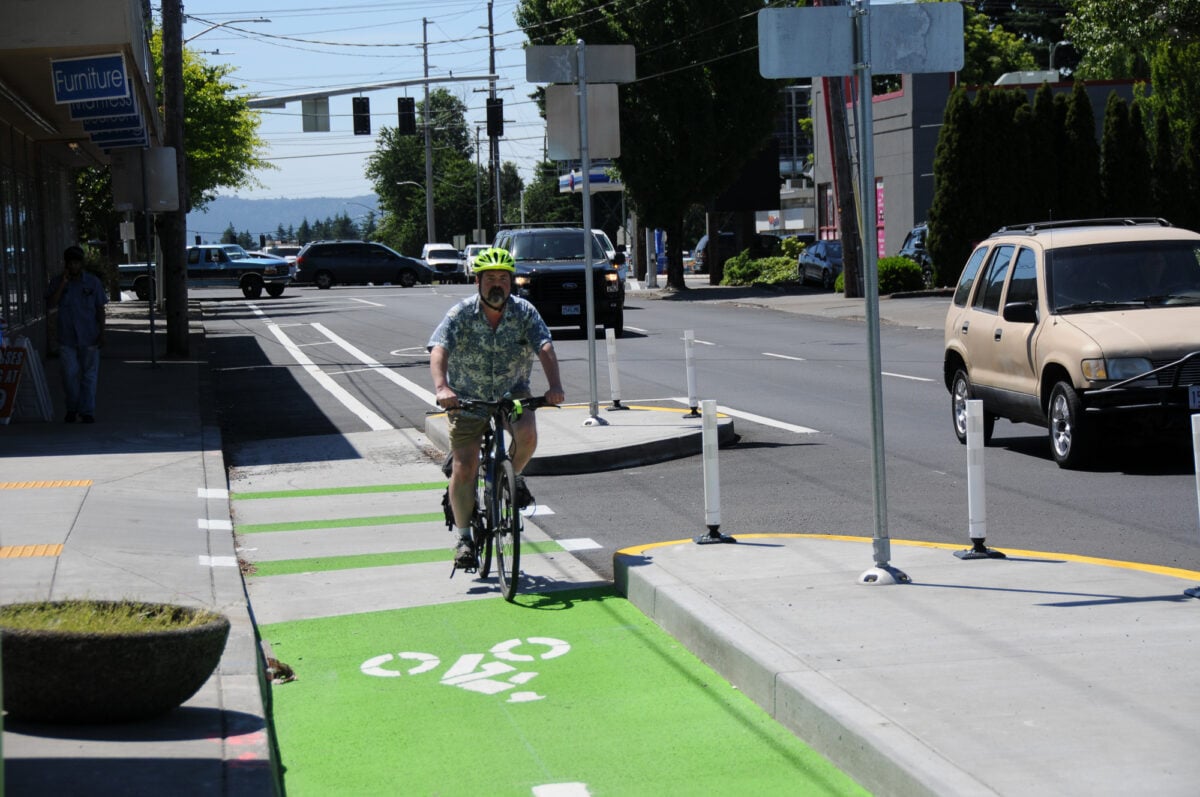
(Photos: J. Maus/BikePortland)
Southeast Foster Road fans are rejoicing today as their beloved retail strip now has dedicated bike lanes. But that’s not the only east Portland commercial area to get new bike access this month. The Portland Bureau of Transportation says they’re about 99% finished with the much-anticipated Halsey-Weidler Streetscape project.
This $5.5 million project is a partnership between PBOT and Prosper Portland that (similar to Foster), aims to use street design changes to improve safety and boost economic development. The city has made significant updates to Halsey and Weidler between 102nd and 112th. Changes include: curb extensions on every corner, new pavement on Halsey, improved street lighting, median refuge islands, three new crossings with rapid flash beacons, parking protected bicycle lanes, transit stop upgrades, new street trees, a “festival street”, a new public plaza, and more.
I spent about an hour so on the couplet yesterday to talk with folks and watch how the street is being used.
“People hate it,” said the manager of a liquor store near 103rd. “95% of our customers have asked me about it… Mostly they’re upset about the loss of parking. This is the main thoroughfare and they took out like 14 spots.” Upon further discussion, the man said he thinks the changes are, “A good idea,” but that’s just been implemented poorly. He didn’t elaborate on how he thinks it should have been designed; but he said he’s heard of two people (drivers) who have been hit as they stepped out of their cars in the new “floating” parking zone (which puts them in much closer proximity to passing drivers than parking at the curb).
Two people waiting for the bus were thrilled with the changes. I watched one man with a cast on his foot cross where PBOT just installed a curb extension and a median refuge island — essentially reducing the distance across by about 15 feet or so. “I wouldn’t have tried that before with my foot like this,” he said with a smile. “I’m not very fast these days.”
A woman behind the counter of Namaste Indian Market (which is wonderful by the way) had some concerns about parking loss. Her store is adjacent NE 103rd, the street PBOT converted from a parking lot/alleyway into a “festival street”. The idea is to make it more of a public plaza with one-way driving access that could be prohibited (via bollards) during events like farmer’s markets. She wasn’t sure what the plan was and didn’t understand the new bike lane and other changes to the street. Once I explained everything, she agreed it seemed like an improvement that would encourage people to visit the Gateway district and make the streets safer.
Advertisement
Here are a few of my observations and images to illustrate:
– The transit island just west of 102nd is a marvel: It makes transit service and biking more efficient, there’s plenty of space for bus riders to get on-and-off, and makes for a nice, low-stress welcome to the couplet.
– From what I could see, the changes are working relatively well. People are still getting used to the new striping and lane configuration. And yes, there were several folks who parked in the new bike lane. Hopefully that subsides.
– PBOT really needs to do more to protect these new biking spaces. Whether it’s plastic wands, concrete curbs or both. And maybe “BIKES ONLY” pavement markings, more signage, and a few enforcement actions to drive awareness. If we’re going to call these “protected” bikeways, let’s be honest about it and give people what they deserve.
– Fortunately speeds on the couplet are relatively low, and the median islands and other changes will only make them slower. People on foot now feel more empowered to cross in more locations, which makes people in cars more cautious.
– Now that we have this great bike facility, we need places to park! I had to park to a sign pole because there were no staples in sight. That should never happen!
– One serious problem is how many drivers coming onto the couplet from a sidestreet block the new bike lane as they wait for a gap in traffic (see below). This is a tricky situation and I’m not sure what the solution is, other than signage and pavement markings. Of course if people were more competent and courteous in general — and if cars weren’t such large and awkward vehicles — this wouldn’t be a problem.
– The new Gateway Discovery Park at 106th and Halsey is fantastic! It’s a modern facility with wifi, places to hang out, and lots of cool amenities. And one of the best crossing treatments is right on the corner so it’s very welcoming.
Here’s a video of me riding the entire couplet (has been sped up 2X to save you time)…
But wait, there’s more…
Bike only signal on 102nd is a welcome touch…
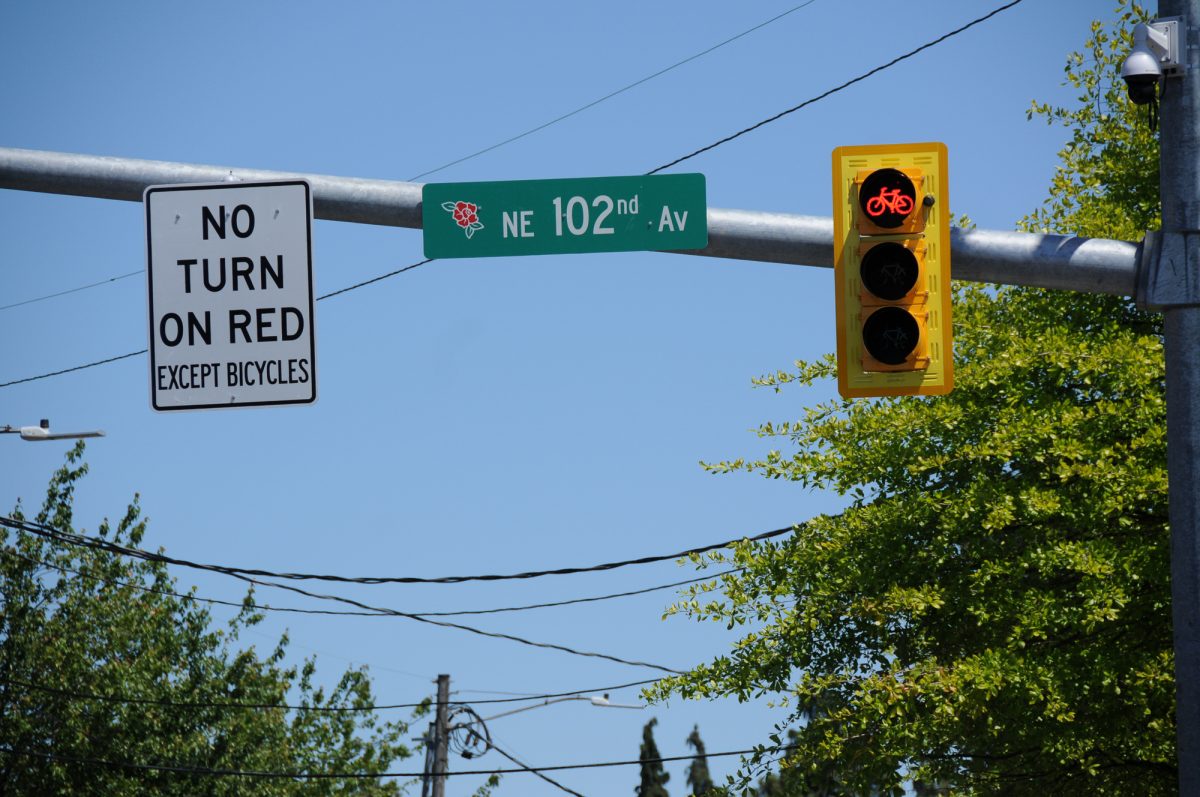
Here’s the current status of the festival street/plaza at 103rd…

The problem with parking protected bike lanes is that you feel kind of scrunched between the cars and the curb. Also not wide enough for side-by-side, social cycling…
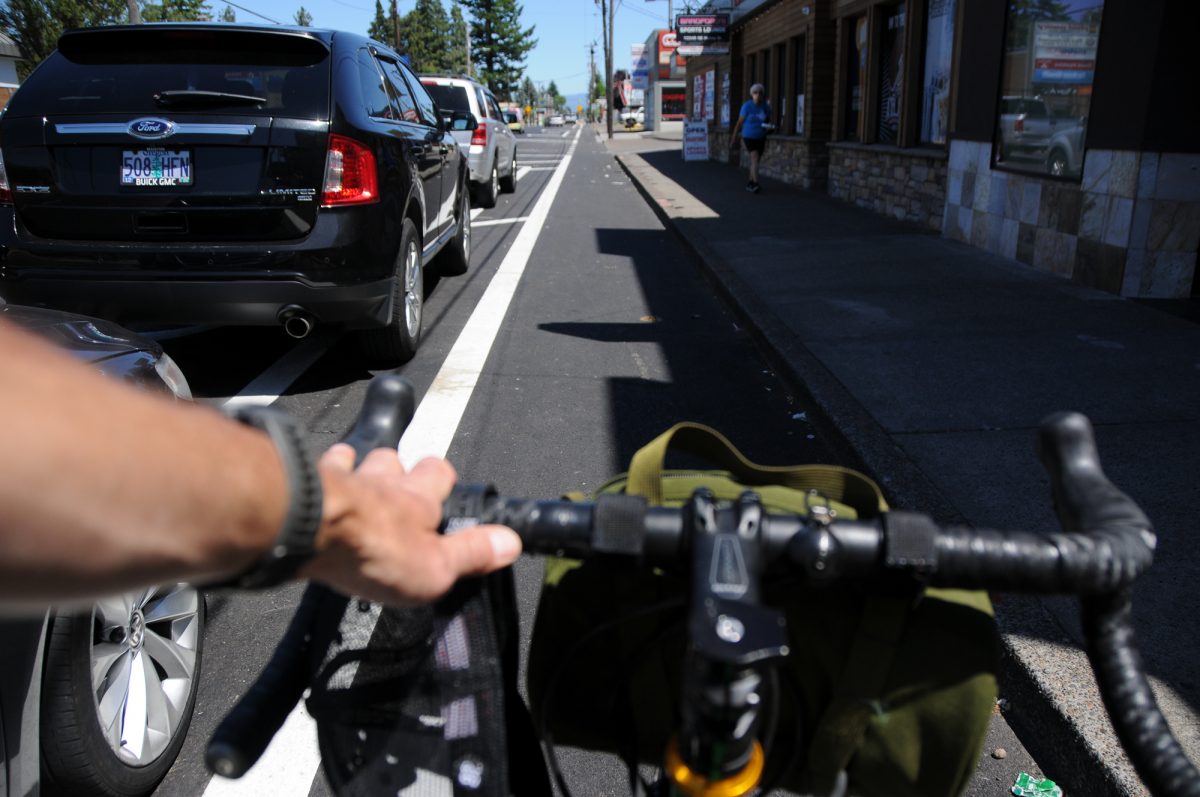
Another view of the crossing treatment at 106th/Gateway Park…

This is a median-protected crossing enhancement at the off-set intersection of Halsey and 108th…
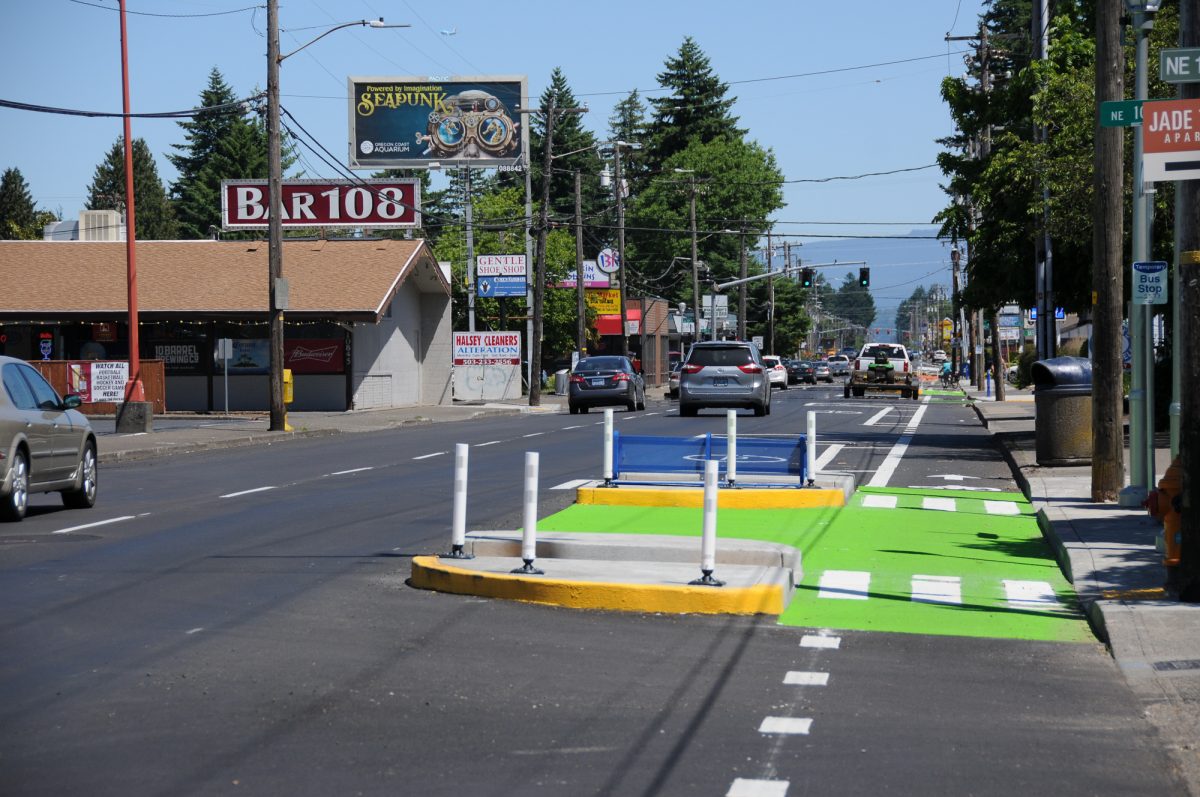
Beyond the project boundary, we still have some work to do…

— Jonathan Maus: (503) 706-8804, @jonathan_maus on Twitter and jonathan@bikeportland.org
Never miss a story. Sign-up for the daily BP Headlines email.
BikePortland needs your support.


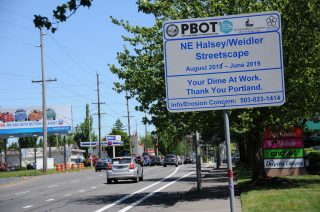
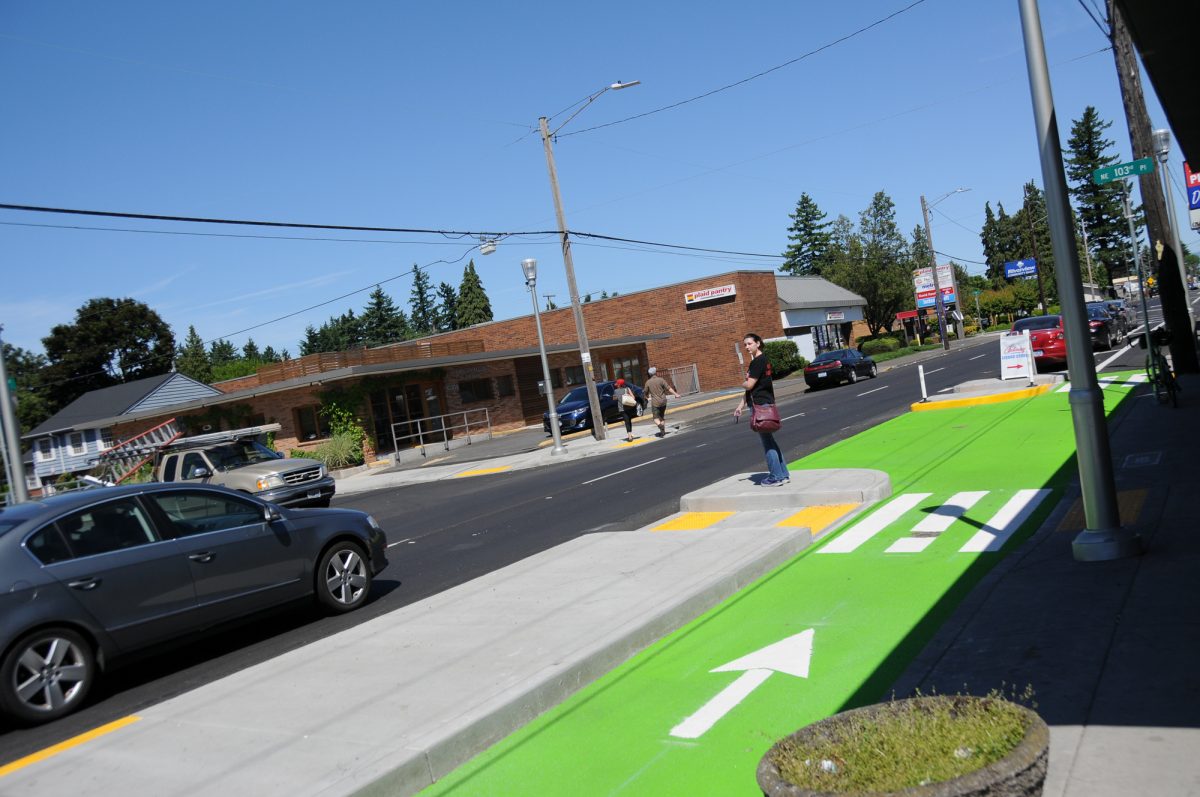
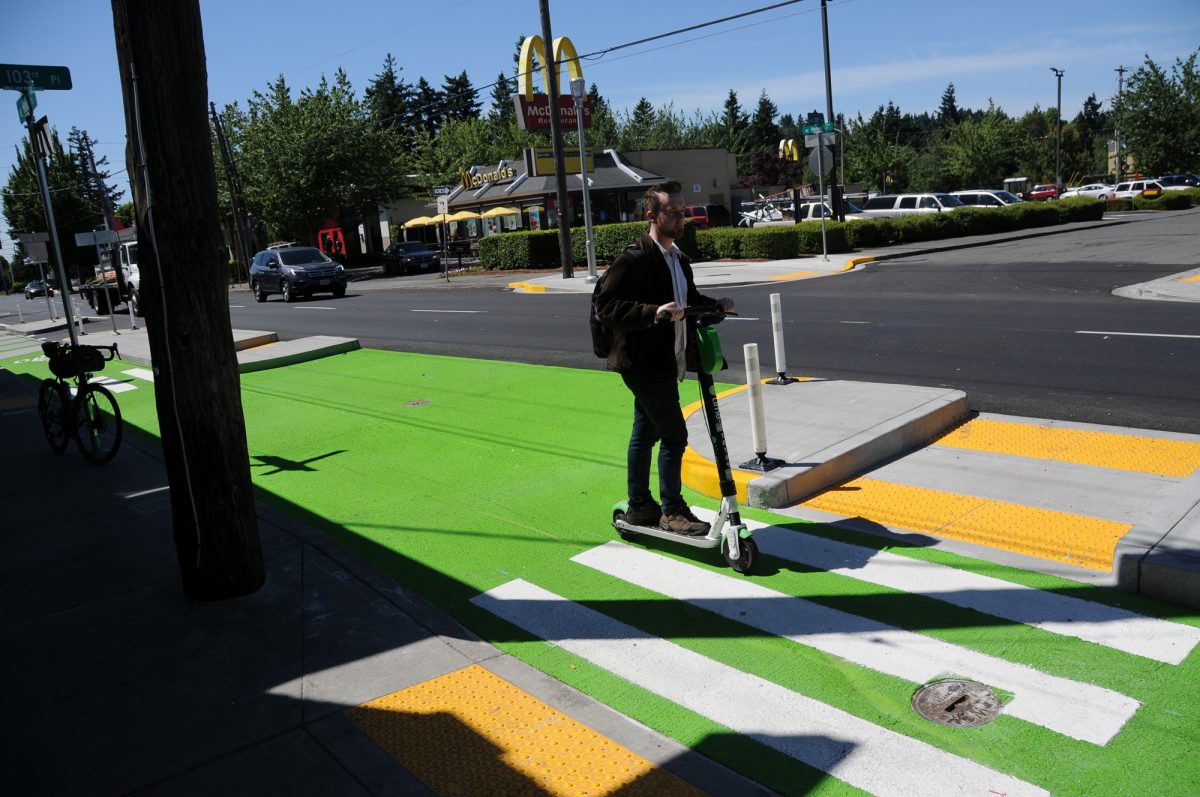


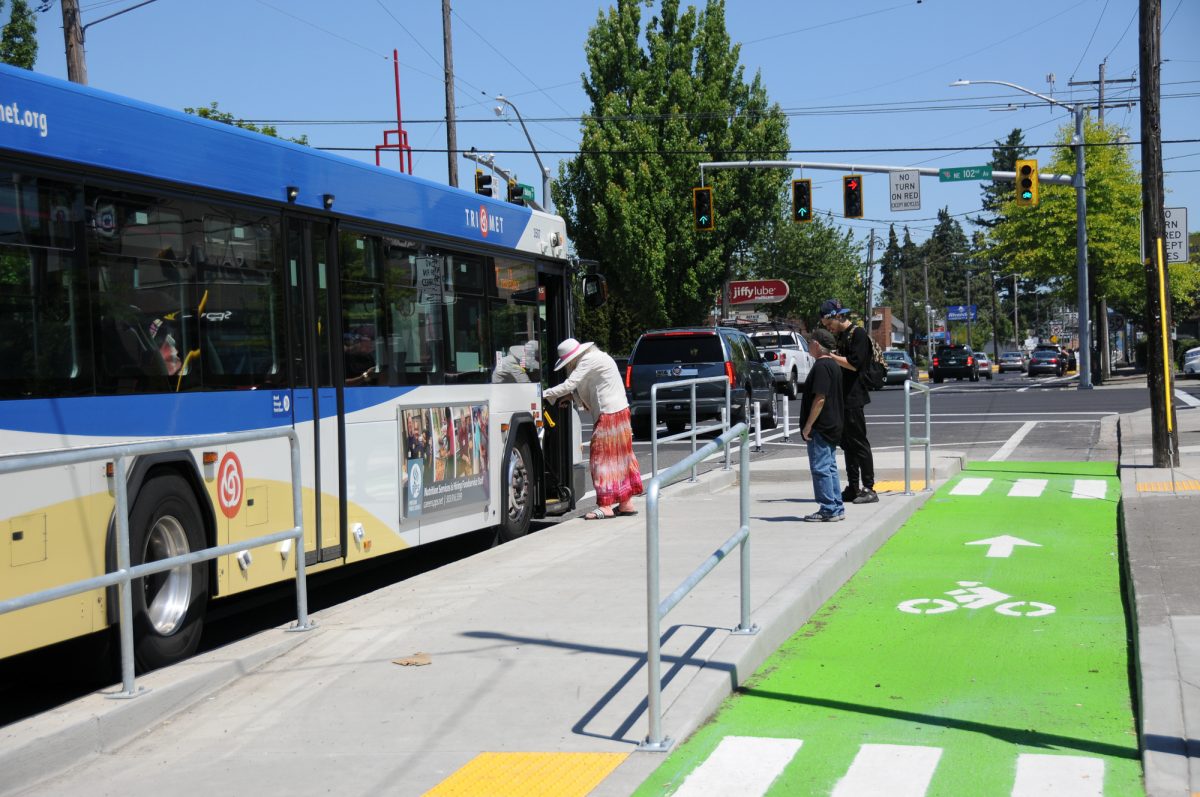
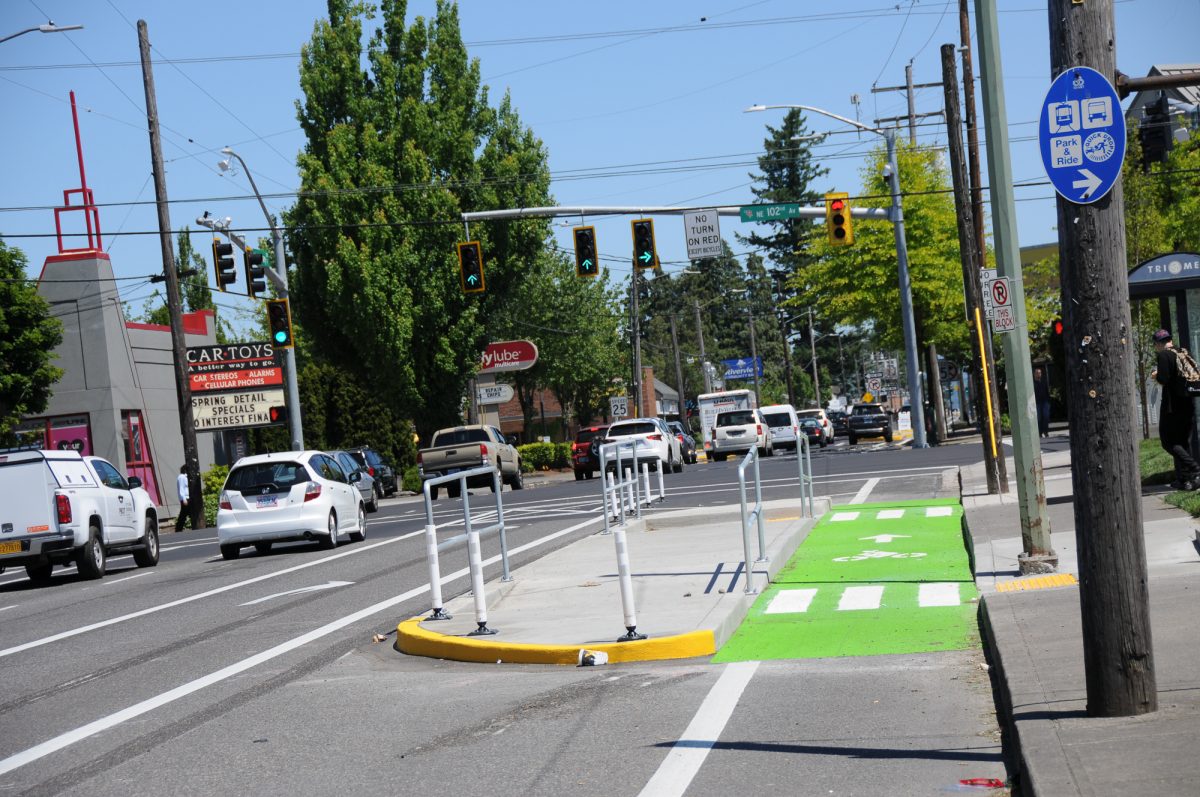

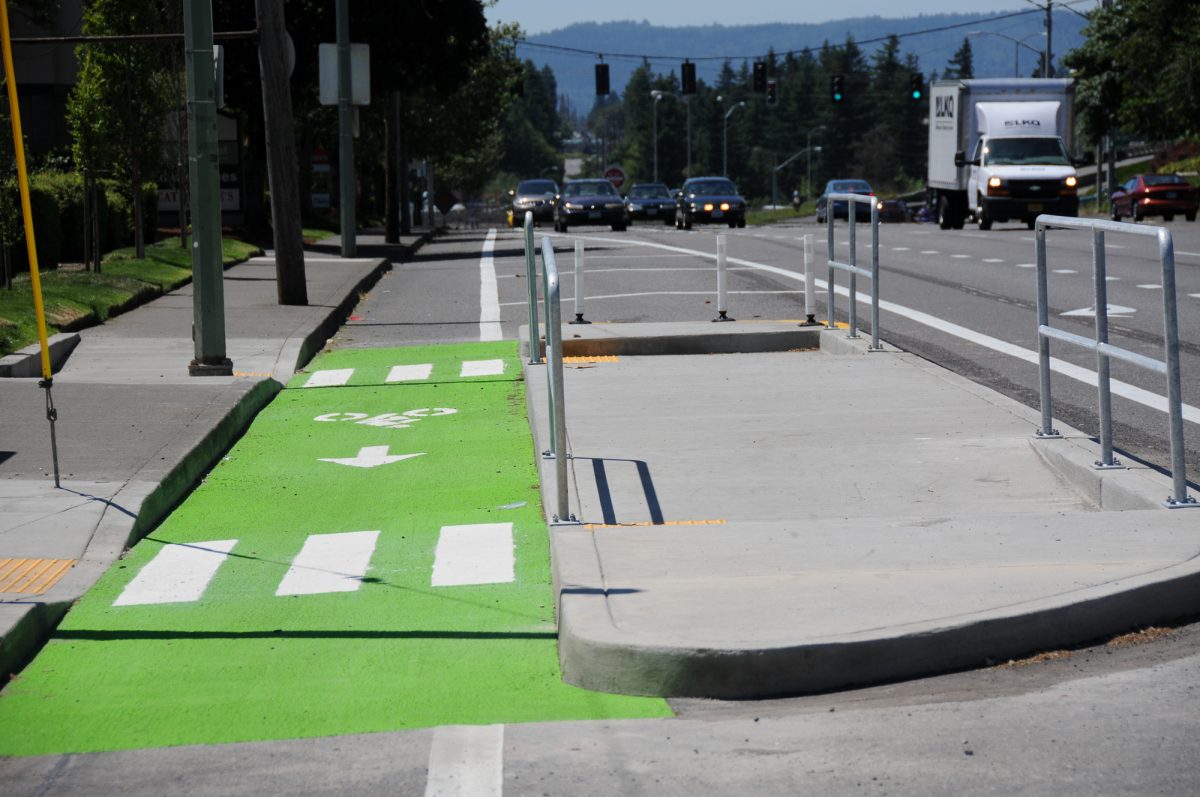
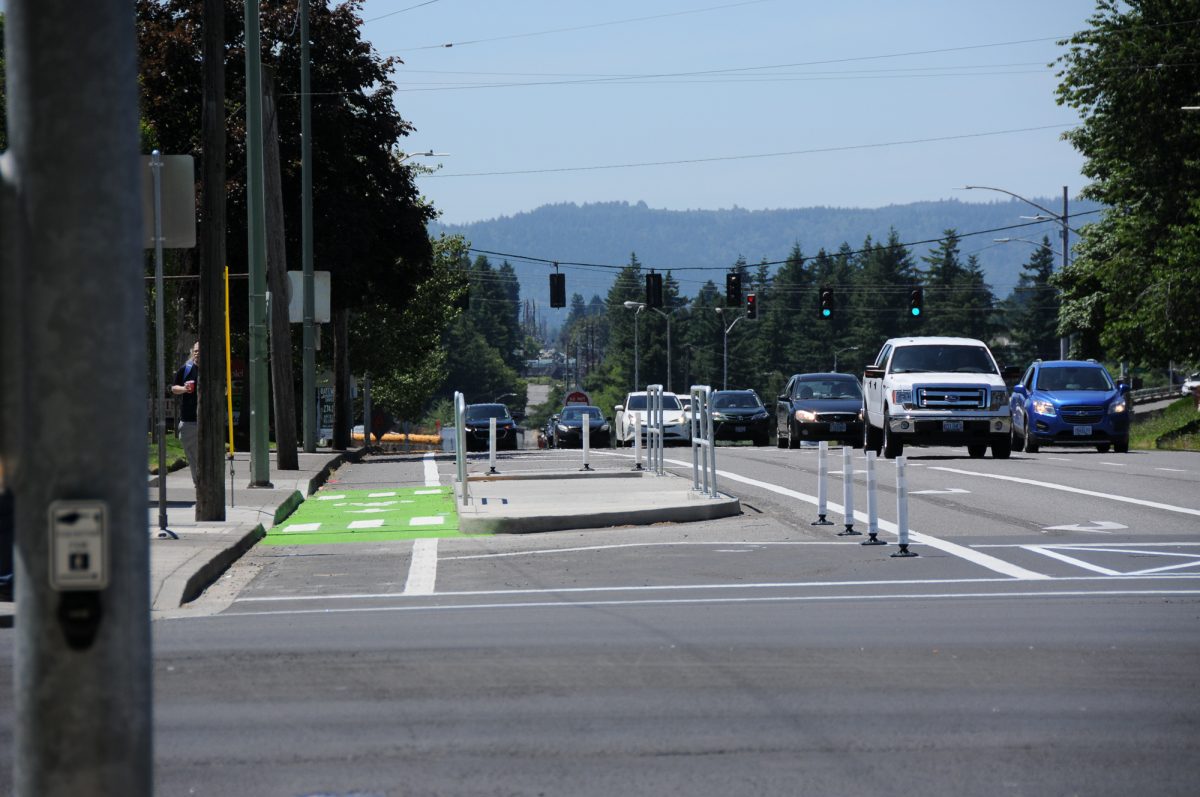
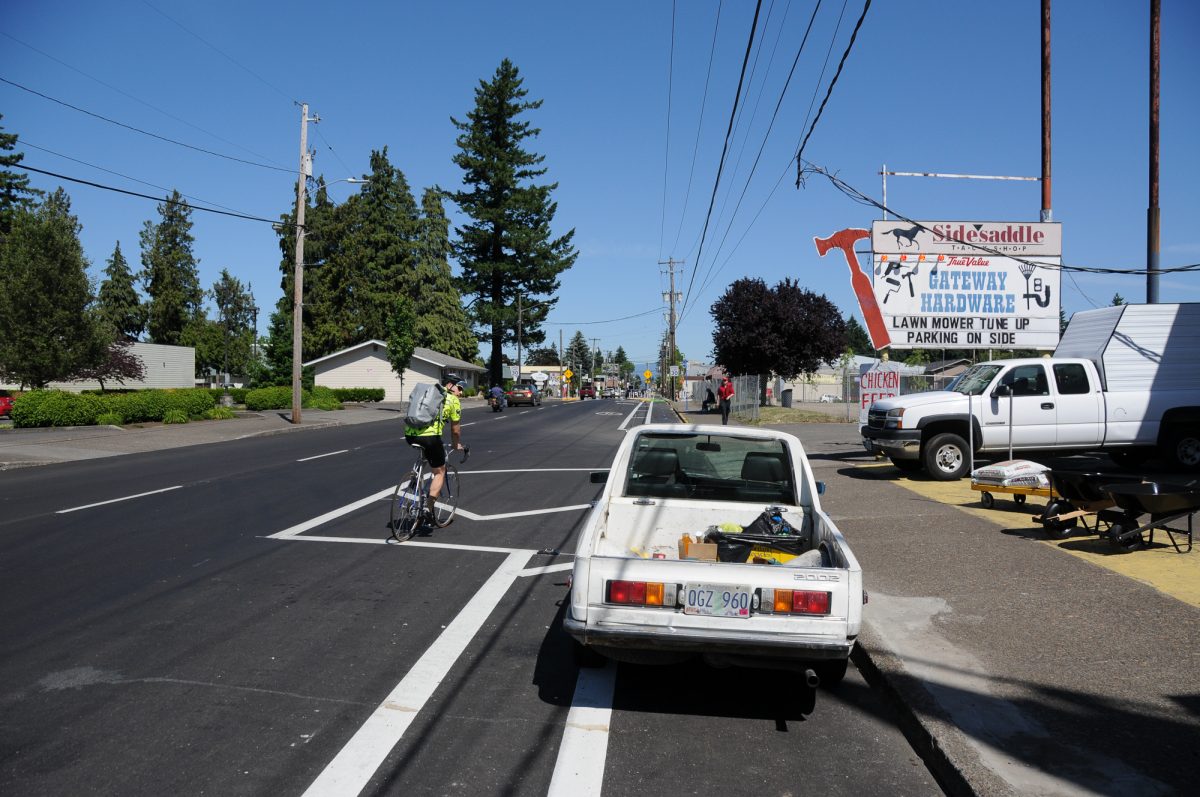
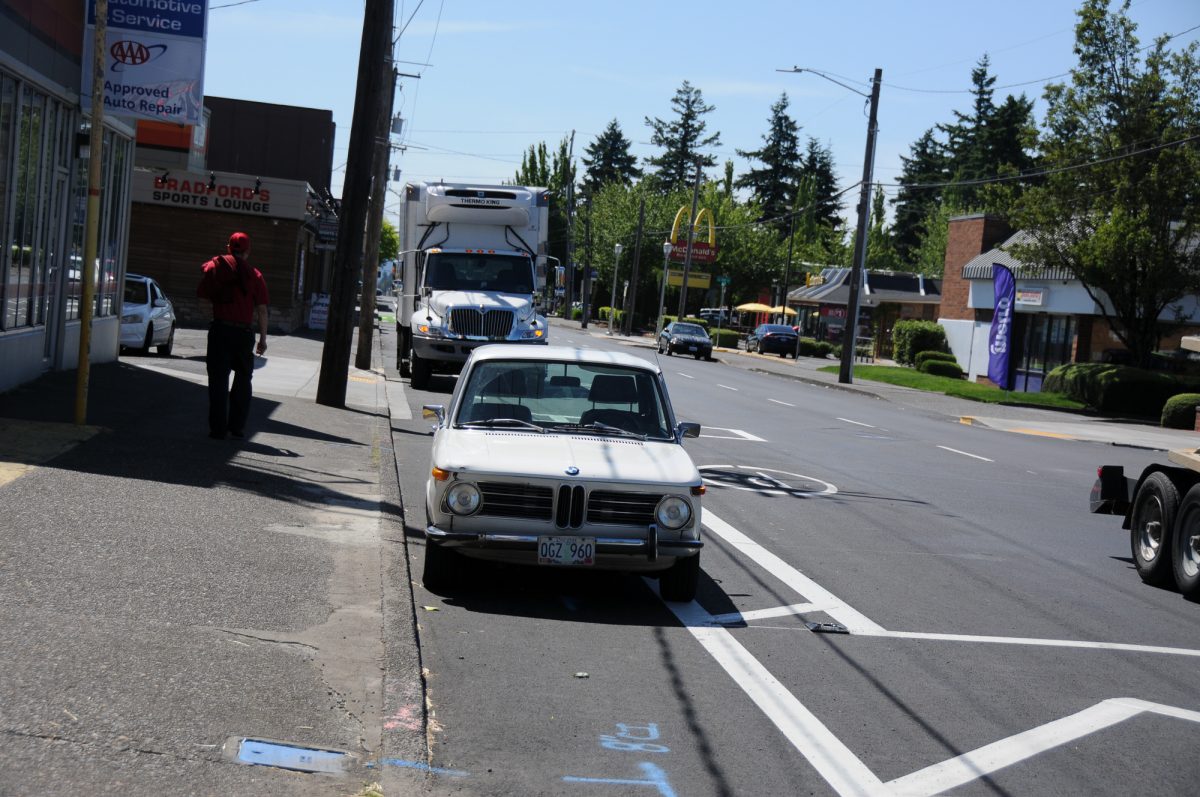
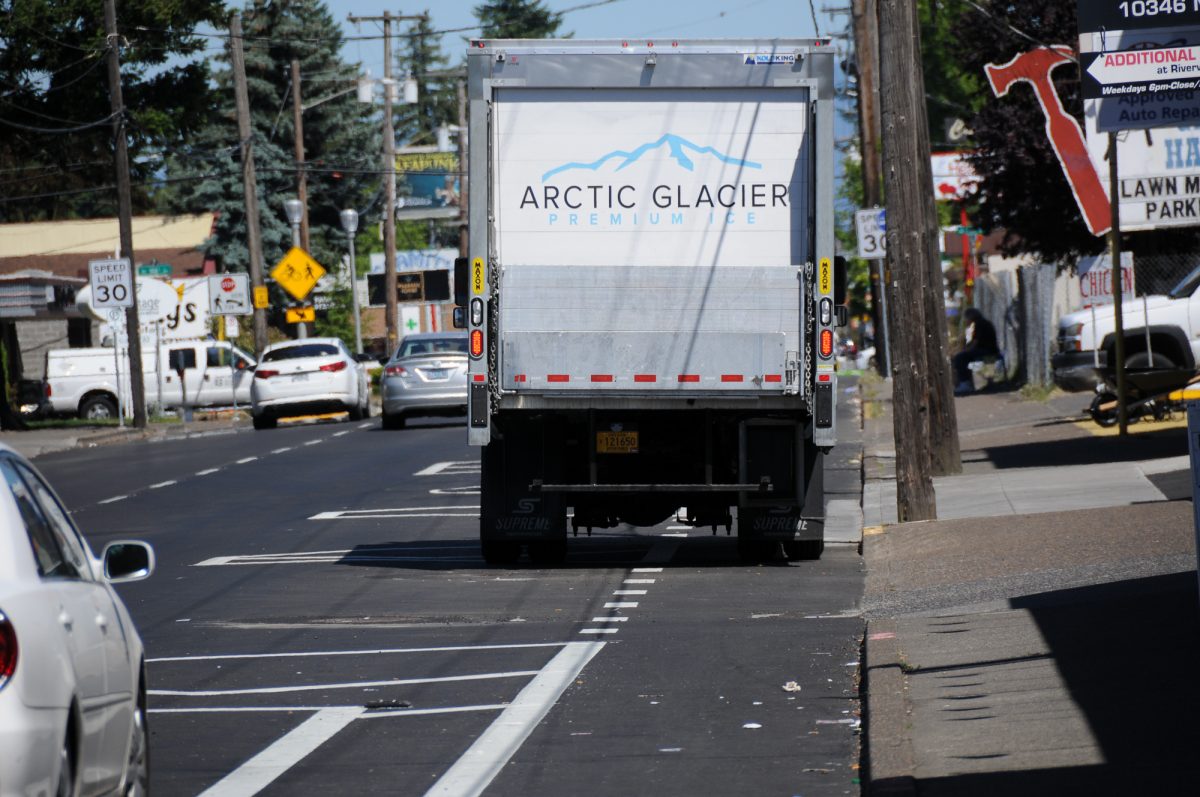

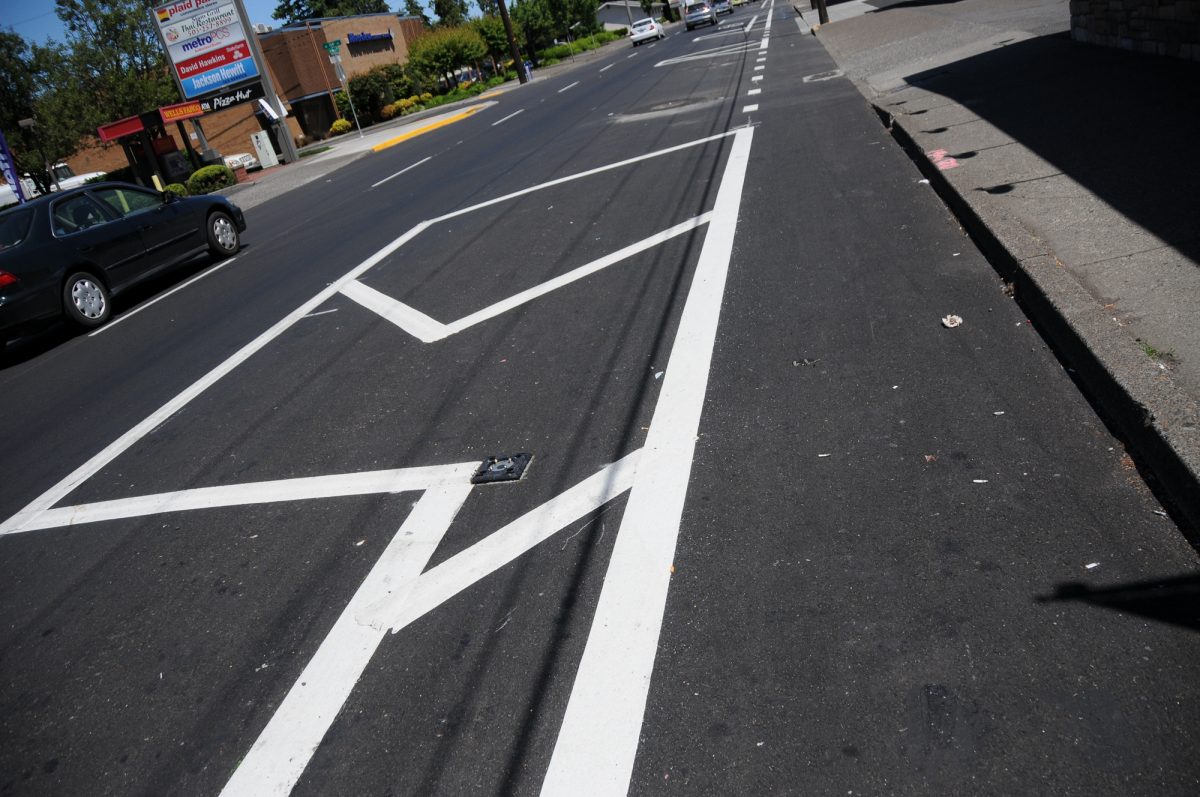



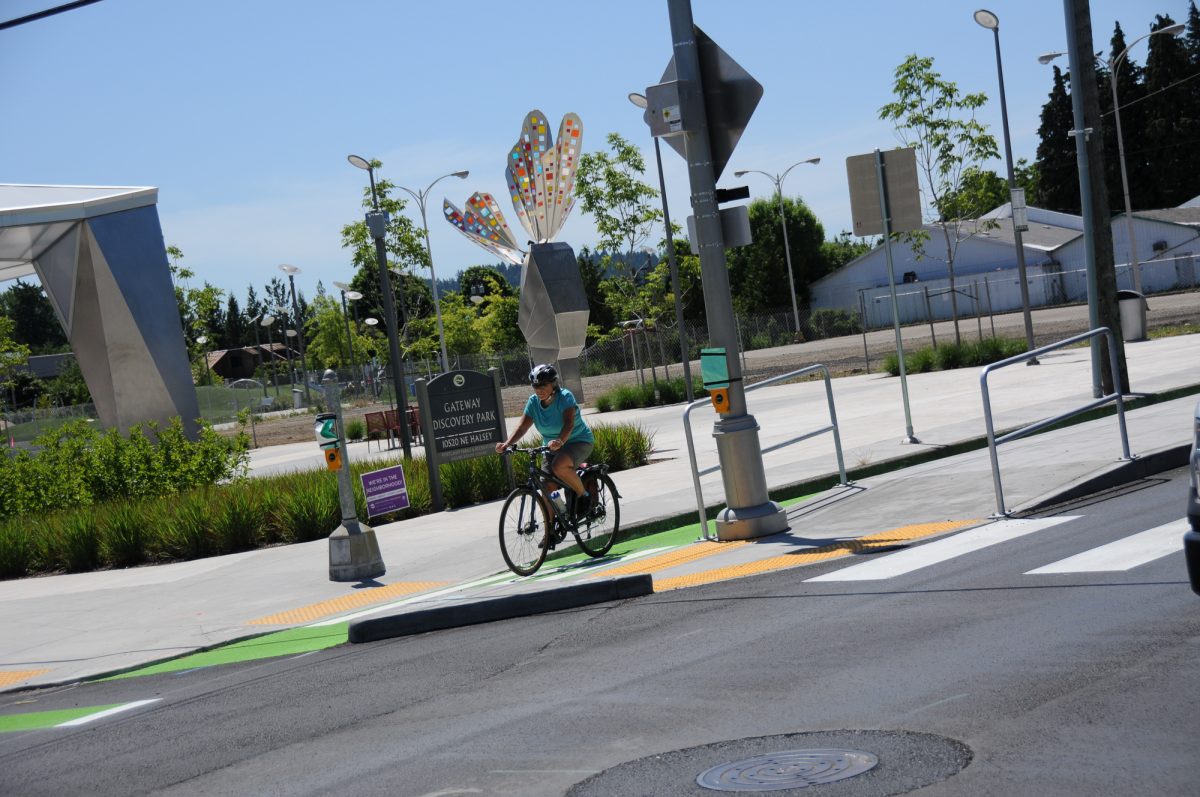
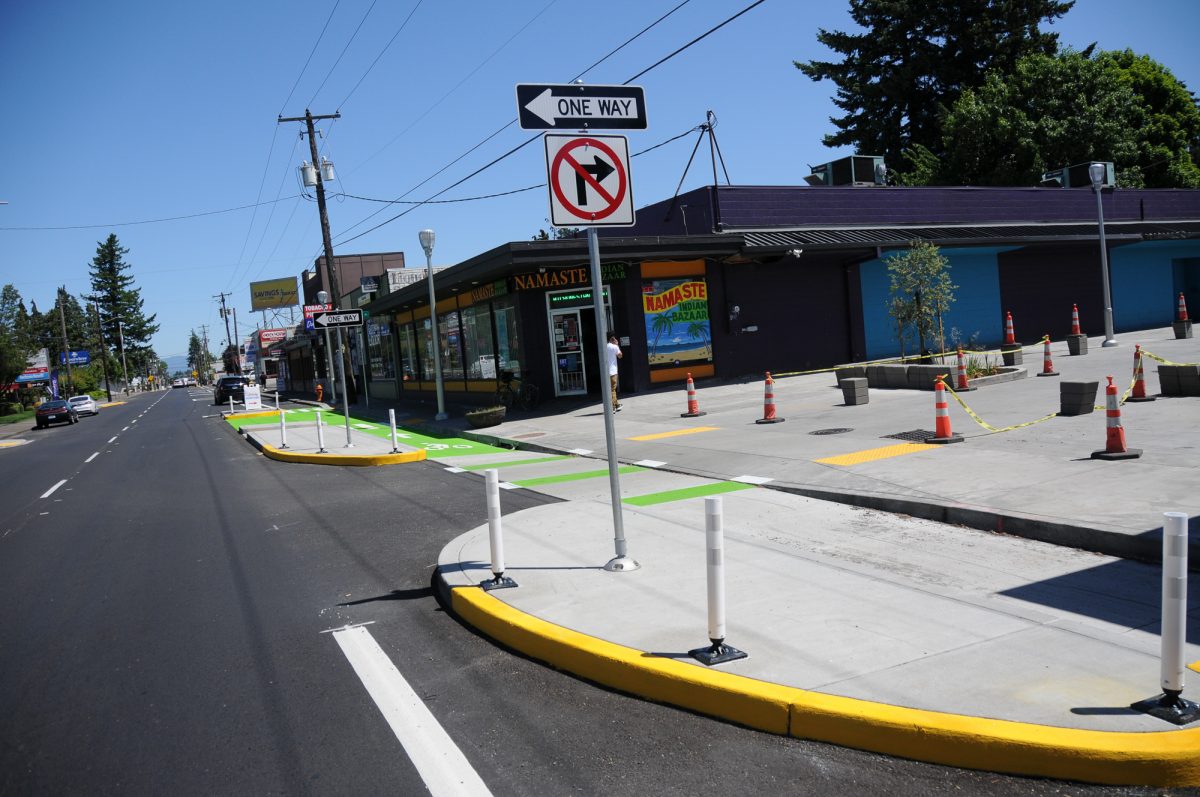
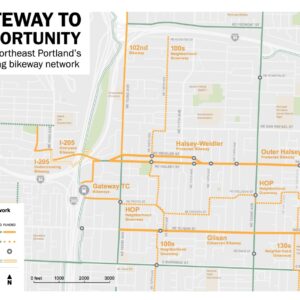
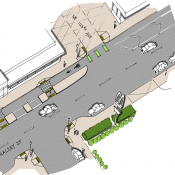
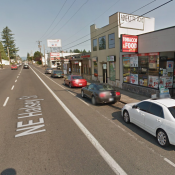
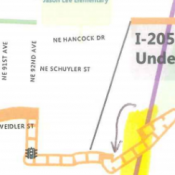
Thanks for reading.
BikePortland has served this community with independent community journalism since 2005. We rely on subscriptions from readers like you to survive. Your financial support is vital in keeping this valuable resource alive and well.
Please subscribe today to strengthen and expand our work.
“If we’re going to call these “protected” bikeways, let’s be honest about it and give people what they deserve.”
It’s not a protected bikeway because most of it is just paint. It has a few protected areas, like the bus island and the intersections.
I agree. It’s more a buffered bike lane with protected intersections, where you need protection the most. Before this facility was built, people would rarely park on the north side of Wiedler Street.
“he said he’s heard of two people (drivers) who have been hit as they stepped out of their cars in the new “floating” parking zone (which puts them in much closer proximity to passing drivers than parking at the curb).”
If this helps make drivers scared that they’re going to be hit by a car then it’s a step in the right direction.
Weird. It’s almost like they should look before they fling their door open? Who would have thought?
>>Hopefully if they start adding staples (please tell me that’s coming), some of those businesses might start seeing even more patrons.
Totally. My first thought was, “well then it’s good that they have more ways to safely get here now!”
I wonder why this design was implemented here but not on Foster. Seems like a very similar commercial area with a previous focus on cars with higher speeds. I understand different parts of the city need different solutions but we’ve got a real hodge podge of bicycle infrastructure throughout and it feels arbitrary and confusing at times why some designs are chosen.
Well this is one for the record books. Someone’s complaining that East Portland got some progressive bike infrastructure before their area of town did.
It really wasn’t a complaint. It was a pondering out loud in the hopes of someone shedding some light as to why one design was chosen over the other for (seemingly) similar types of street and commercial corridor. Is it the ‘cul-de-sac’ winding nature of the neighborhoods off of Halsey vs the more ‘gridded streets’ of Foster-Powell? The latter being more favorable to greenways and the former being more favorable to separated infrastructure on main arterials. Just some thinking out loud and seeking ideas. I don’t live in either of these neighborhoods but pretty much every neighborhood in our fair city could use some modernizations/ connectivity in infrastructure. On a separate note, I sometimes find the comments section here to be a bit like the Life of Brian. We can chatter on and on ‘Paint Protection’, ‘Floating Bus Islands are terrible’, ‘greenways are submitting to car culture’, etc… all the while finding little to agree on. However, I do know we can all agree we must unite against our common enemy, The People’s Front of Judea. 🙂
It’s just because the Foster project was designed several years before the Halsey/Weidler project. Due to delays in the Foster project, they ended up being constructed at the same time, but Halsey/Weidler was designed after parking-protected bike lanes became common practice in Portland, whereas Foster dates from the days of regular old bike lanes.
Foster’s door zone bike lanes were designed in 2012-2013. At this time, enhanced or protected bike lanes were established *best practice* in Portland for streets like Foster. For example, most of Portland’s protected bike facilities *predate* the design of Foster’s new door zone bike lane:
https://bikeportland.org/2009/08/31/first-look-at-portlands-inaugural-cycle-track-22932
https://bikeportland.org/2011/05/19/riding-portlands-first-real-cycle-track-on-cully-blvd-53320
https://www.oregonlive.com/commuting/2011/11/portland_opens_new_cycle_track.html
https://bikeportland.org/2012/11/09/first-look-new-protected-bike-lanes-on-ne-multnomah-street-79880
S, visit the two sites. Foster is a 2-way street, Halsey-Weidler are two one-way streets with a lot more space to work with.
This is why.
With all of the turning traffic, parking protected lanes on Foster would be very dangerous. Left-cross crashes would be a huge problem.
and today on bike portland i learned that the only two options are “parking-protected lanes with no space before intersections” or “door zone bike lanes”.
Correct me if I’m wrong, but is that the famous (East Portland bike advocate) Jim Chasse in the top photo?
I have to give that bike lane blocker a pass just for retrofitting that BMW 2002 with a pickup bed.
Sure wish we had transit islands on Vancouver and Williams!
I hope/ wish they add something on the other side of 205. If you’ve ever pedaled up Halsey from 82nd, you’ve enjoyed almost being hit by cars plenty.
There is funding lined up for a complete redesign of NE Halsey from 47 to 205/Gateway Green and this project. Should hit design phase anytime, construction by 2021.
There is also funding for a redesign of Halsey from 114th to the east, so basically all of Halsey is going to be transformed in the coming years. Except the section in Hollywood, because nothing ever changes in Hollywood. 😉
The portion from I-205 to 114th is within the Gateway Urban Renewal Area which helped fund it a little bit, but mostly they used TSDC funding on it – it was on the original 1991 list for “bike lanes on Halsey” for TSDC funding. Finally after 28 years it gets implemented. Foster hasn’t been delayed nearly as long, and it was funded mostly with MTIP funds.
Greenways completed or significantly upgraded in bougie inner E Portland in past 7 years:
20s
50s
Rodney
Clinton
Ankeny
Lincoln-Harrison
Greenways completed or significantly upgraded in outer E Portland in past 7 years:
∅
PS: PBOT claims that the 130s will be built this year but after 4 previous build dates I’ve heard this story before.
There’s an online open house right now for the Halsey and 60th project, and unfortunately it doesn’t show any bicycle facilities on Halsey at all (rest in peace, oh sweet 2030 Bike Plan).
https://hhprinc.wixsite.com/ne-halsey
I’m curious why you’d take Halsey and not just jump up a couple blocks to the Tillamook bike route? I commute from Parkrose Heights to Irvington daily, and I only use Halsey east of 92 (admittedly, it sucks that you have to take the sidewalk on the Halsey overpass that goes over 84 and 205). I’ve never once wanted to take Halsey further west.
Halsey’s a lot more direct and faster. When I lived in Portland (1997-2015), I’d sometimes ride it from East Portland to Hollywood. During low-traffic periods, it’s actually quite a pleasant street. The narrow traffic lanes insure that cars don’t go too fast, and given the non-peak traffic volumes for most of the day (and all night), the street could easily have a road diet to reduce lanes to one each way, with bike lanes and a center turn lane, which it already has on many of its overpasses.
In any great city, you need both low-stress back streets for long bicycle commutes, which Portland has always been great at, but you also need safe and low-stress bike lanes on main streets to access businesses and jobs, which Portland still has a lot of catching up to do.
I go eastbound on Halsey in this stretch at 5:30am most mornings. I won’t do it after 6am. Too much traffic.
All this paint and concrete…and still no good way to head downtown except the crappy Halsey sidewalk.
Rode them today! Such an improvement. I’m hopeful that someday they go all the way from 92nd to 122nd.
Checked in at the Outer Rim bike shop to chat with the employees about the new lanes. Said all employees were against the lanes and that Portland is too anti-car. I have a feeling though that that sentiment will change. I think it reflects an area that has not had any good bike infastructure for a long time. Passed by two older guys heading to dive bar and they both said they liked the changes.
Also that park is amazing! I didn’t know until today that there is a Food Fight grocery store on Halsey.
Wow, that’s really disappointing to hear that the only bike shop in the area is against bike infrastructure. TBH, I’d love to see someone with better sense take over that shop.
I’m usually a hater when it comes to parking protected bike lanes, but I have to say, these are much better than others I’ve ridden. I think a key part of that is 1) having proper buffer zones between parked cars and the bike lane, and 2) blocking off enough space around intersections that visibility isn’t totally obstructed.
As far as people whining about parking, I’ve ridden this almost every day since it’s been put in, and there’s always plenty of parking.
I wish Portland were too anti-car!
Wow. I definitely won’t be giving them any of my business.
Same here, I’m not anti car but I’m definitely anti anti bike.
A home-owning bike advocate who lives in gentrified NE Portland criticizes working-class East Portland residents for being “car-dependent” largely due to intentional socioeconomic neglect by inner Portland-centric city government.
You picked a good thread for this rant.
As for reinforcing the bikeway space vs. the parking space/ buffer…how about RPMs (fort he dark winter) and the big old school half-moon turtles (super sized Botts dots) or euro hedge hogs? Stay away from the wands please, except in limited low speed areas.
Jonathan – please add a note to your great video..it looks like you purposely sped it up to make it easier to watch (thanks)…but this change also makes the traffic look like they are doing 50 or 60 mph! 😉
This looks really good, and I look forward to riding it soon. Hopefully this sets the floor for the quality of new bicycle facilities.
I particularly like the floating bus islands. Unlike the design for the stations on Outer Division, this allows a bicycle rider to pass a stopped bus without creating a conflict between the bike rider and someone getting on or off the bus.
“PBOT really needs to do more to protect these new biking spaces. Whether it’s plastic wands, concrete curbs or both.”
The contract plans show flex posts in the painted buffer. From the photos it looks like the bases have been installed, but the posts themselves aren’t there yet. I’m not a big fan of flex posts, but they’re better than nothing.
Bases have definitely been installed. Looks like they’re just waiting for the plastic wands. I must say, I like those plastic wands a lot more as a parking deterrent than as a “protective” measure.
From what I’ve observed, the plastic wands seem to work pretty well as parking deterrents in downtown Washington DC, along the semi-protected bike lanes there on “L” and “M” streets. They usually keep car drivers from wanting to park within the lanes, but when the heavy delivery trucks drive over them, they don’t break nor permanently bend, they’re quite flexible.
I saw them putting in some posts yesterday!
Not bad overall. Narrower lanes than it should have but maybe all they could arrange at this time.
The locations of the green paint seem opposite to me. It’s where it doesn’t need to be and not there in places where it should be. It’s used to indicate to people when driving that a cycle lane is there without protection. It should be at the intersections. It’s not necessary within a curb. The curb already indicates a cycle facility.
The parking protected lane looks good. There just needs to be the occasional concrete curb to keep people from parking in it.
But they’ll figure it out after awhile. It’s a good start. Now to connect it to the rest of the network.
Very first photo – where are the crosswalks?
All other photos: Would it kill them to plant a tree? Cheaper than the endless fields of concrete they love to build. IE: Right before the bus island. Plenty of room!
The first photo is a driveway to the festival street. Where are you expecting a marked crossing?
Where in the bus island photos is space for a tree in the public right of way. It’s a curb tight sidewalk, not 12′ wide?
The existing sidewalks are fairly narrow, and don’t have room for trees to be planted. That said, the new park has wider sidewalks around it, with street trees on all the perimeter streets:
https://goo.gl/maps/oAgoubh6QySQSGtdA
The Halsey 106 apartments, set to go up beside the park, will also include new sidewalk and street trees:
http://www.nextportland.com/2018/09/06/halsey-106/
I think that’s cancelled unfortunately. Construction was suppose to start back in January. The site is completely empty and not showing any signs of activity
The big issue I have with this is that it isn’t a transportation project, it is an economic development project. Give it a few years and many of those businesses will be pushed out, the rents will be raised and Gateway will be a new hip area to hang out all night. I’m sure an olive oil shop, trendy bars and niche bakeries are coming soon. Maybe they will tear down the McDonalds and build one of those 6 story boxes that rent for $3,000 a month
Everyone wants a Trader Joe’s there, just like every other low-status community nationwide. The new Indian restaurant replacing an arcade was the beginning of a nasty process you’ve quite accurately outlined. This new facility merely accelerates that process, but the process has been under way for quite some time already. Next to go will be the golf store at 112th, the historic breakfast diner that Obama ate at, and the shoe repair at 110th. Already the boutiques and yoga studios have moved in; next comes the dog groomers, Pottery Barn, and Whole Foods. Thank the gods for the 2 WINCO stores, at least there’s some normality still there.
Possibly true David, but as long as you’re stereotyping, show me a WINCO style streetscape that isn’t also filled with steroidal pickup trucks and bloated SUV’s. One that isn’t mostly giant asphalt parking lagoons and brutal to all but motor vehicle users. (well, brutal to them too in truth) Wish we could have both human scale infrastructure and non-gentrified commerce in the same places but with our culture it seems either/or sadly.
…And part 2 question David is: If one must choose, which do you want; WINCO style commerce zones that you can only drive your truck to (and have access to plenty of auto parts stores and car sales lots too) or Trader Joe’s zones that you can walk or ride your bike to? I know my choice if I have to make it, which apparently we do in the US. Again, wish that wasn’t the case.
If you’re in the position to make the choice there really is no choice. The issue is that there are many, many people who cannot afford to live in a gentrified neighborhood and it bothers me that we spend money that could go to real transportation projects to create new vanity neighborhoods.
The inner Eastside didn’t need a streetcar, The first few years it ran near empty cars. The streetcar was built to bring in developers, just like these bike lanes, floating islands and park were all built to bring in development.
Overall we’re talking about a dozen blocks of improvements. You still need to take your life in your own hands to bike there.
This project, even though it is near a light rail line, has no connection to it. They need to connect that. Close off the road between Kohl’s and Fred Meyer. make that a grand pedestrian / bike plaza that goes all the way over to the Max.
As it is now, they’re creating a new neighborhood and not improving an existing one.
Hmm, difficult choice. Trader Joe’s is a private corporation owned by a single individual worth over $4 Billion. WINCO on the other hand is owned and operated by its workers (but is also corporate, not a co-op.) TJ caters to rich folks wanting high-value goods at low prices. WINCO caters to poor people feeding their large families, especially for immigrants. TJ provides for excellent bike parking while WINCO has terrible bike parking and high theft rates. Tough call.
i live and bike in this neighborhood. biking wise this is a major improvement. the cars are having a hard time adjusting and many people still park in the bike lane. this forces me on a bike to ride into halsey around them. car folks feel like they are going to get hit opening their doors and exiting into the lane on halsey (a valid concern). while people adjust to the change it has started to slow down the traffic which helps to make the area feel more pedestrian and less thoroughfare. everyone needs to be patient while we all figure out how to use the new amenities.
A family I used to know that lived on this street called it the “Halsey Hellway”, and I can see why.
I’m terrified even driving on this street, no joke. I sometimes hit up the Food Fight vegan store out on Halsey here, and there is do much aggressive driving. You slow down to make a 90 degree turn into the parking lot and some asshole is laying on the horn like you’re stopping their progress to the ER Dept for their wife to go into labor.
I’m glad to see these changes.
I agree with others though – it needs WAY more separation with plastic wands, and WAY more bike signage markings down on the pavement.
If drivers in places like downtown & Lloyd District where there are squillions of bikes couldn’t figure out not to park in a marked cycletrack, I don’t know on what planet PBOT expected suburban drivers who don’t even know what a bike looks like to do.
My experience is that these islands do a good job of limiting the speed at which one can safely cycle through. I do feel a tiny bit self conscious about using a wide lane on the moto side of the island- but it feels safer closer to the center of the road (better sight lines) than hugging the curb, and being funneled into dynamic and sketchy situations. Does anyone else experience this?
Nice to see the improvements. I just hope they get used a lot. I’m a daily rider, but I cringe when I see new bike infrastructure when there are hardly any cyclists using them, especially at rush hour when the reduced number of auto lanes are all backed up (NW Everett in the Northwest District is an example of this – the Cully platinum level separated bike lanes are also too little used). Fancy new infrastructure with few bikes is not the best way to win over skeptics. I think one problem, besides not enough cyclists, is that Portland’s highly improved bike facilities are scattered and not continuous enough to get you far with a feeling of safety.
I ride the Cully section you speak of, but bemoan the seas of glass and debris the lanes accumulate as they’re not “swept” by motor vehicles automatically. Then dodging recycling bins and parked cars that sit in the lanes. I sometimes think it’s better the city not build this kind of thing at all than to build, then ignore maintenance and enforcement! Result can be me just forced to ride further out into traffic than I would if there was nothing at all provided for bikes!
Well, if I had to get from the McDonalds down to the bank I’d totally use them. But in just a minute or 2, you’ll get dumped back on the freeway that is Halsey.
Heh. Driveways. It’s nice they wanted to create “protected” intersections, but unless they are signalized, the risk of being hit from the right by drivers pulling all the way through to the forward edge of the islands—or as you encountered twice on one run—drivers blocking the bike lane while waiting for cross traffic to clear increases. And now there is no swerving around the nose of a car that you expected to stop prior to entering the bike lane. All you can do is stop, which likely makes the driver believe you are ceding your ROW to him and creates either a bad pattern of backwards ROW rules, or one of Portland’s famous “go-no-YOU-go” situations.
The only “fix” for this is to divert the bike lane to the right so that there is space for a car (but probably not a truck with a trailer as you encountered) to pull all the way past the bike lane to wait for cross traffic.
Also—and this is my absolute biggest beef with “protected” bike infra—the 2X-speed video looks like it varies between .5x and 1x the speed of my daily commute video. I realize you had a specific mission to video this segment and so were likely going slower than usual, but I will never feel accommodated as a bicyclist if—right next to a road designed to allow cars to travel at 25-30mph—the bike facility I am expected to use has a max “safe” design speed of 10. Not claiming I can maintain 30 like the real grown-ups, but I’d love to be able to do 15-20 without feeling like a daredevil or being reviled by all and sundry as a “scorcher”.
This looks like a whole new set of hazards to me. Guess it’s not for me.
Ah, bike shops. Not generally a place for Nike advocate types. Generally full of basic Bros who feel invincible, no kids and generally are too cool for us soft folks who actually advocate with kids. Personally, bike shops days are numbered. Bikes are quickly becoming better made, need less maintenance and online is the way to go. So, I don’t care they hate on true infrastructure .
As for the gentrification thing….look low value, low slung homes aren’t the future. Does the city screw up and allow barely adequate housing supply (a four story when an 8 is actually needed)…#all the time. Does the city mess up and not reuqire 10 percent have required low income? Yep. Those are reall issues. Hey, WinCo can easily section. Off part of it’s parking lot for high density housing. But, since they live in the past, they won’t.
Gentrification is good. It is all about government making sure there is room for everyone. Not just rich whites.
“Does the city screw up and allow barely adequate housing supply (a four story when an 8 is actually needed)…#all the time.”
Give me a break.
“New urbanist” bike advocates are not advocating for working class rental housing. They are advocating for $500,000 ADUs and $700,000 “small” houses. The kind of fancy-micro-housing that upper-income-potential college-educated mostly-white TINKs prefer. Is it any surprise that cycling advocacy has become virtually synonymous with classism and racism in Portland?
When I hear the words “Jane Jacobs” I feel rage.